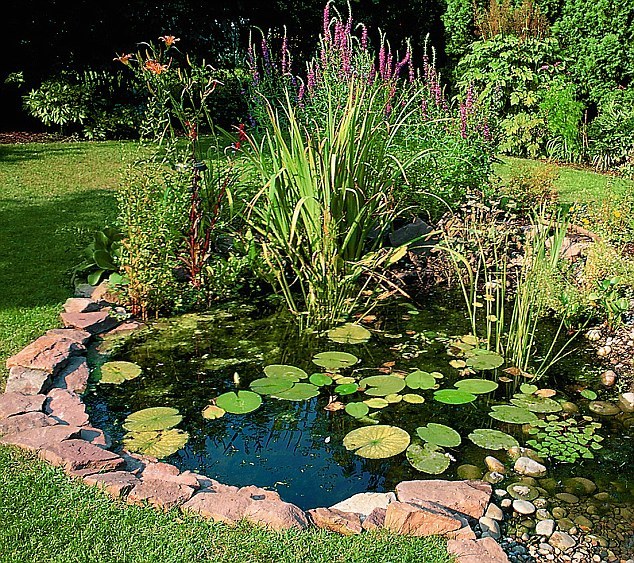Taking Care of Goldfish in a Pond
The trusty goldfish is an old favourite for many, and they are regarded as perfect pets for the garden pond. Of course, goldfish may be kept in spacious, well-filtered aquaria (with a large surface area for oxygen exchange), but they will very much appreciate the freedom and space that a garden pond can provide. Given such an unrestricted expanse and favourable water conditions, this is a fish that has been known to grow larger than 45cm (18") and live for over 25 years.
In general, the larger the pond, the easier it will be to look after, as long as it is sited in an appropriate position. This is because when it comes to water chemistry and temperature, larger volumes of water are much more stable than smaller ones. Whilst a pond can never be too large, it can be too small if you don't plan ahead and allow for growth of the fish.
Ponds can either be dug into the ground in a shape that you prefer, built as a raised feature with most of the pond above ground, or, for ease of installation, there are also pre-formed fibreglass or plastic ponds available in many rigid shapes. Formal gardens tend to lend themselves to square, rectangular, or perfectly circular ponds, whereas kidney-shaped or free-form of your own design look the most natural in the majority of other settings.
Filtration is essential for the goldfish pond. Not only does it help to keep the water free from various debris, more importantly the filter media inside will colonise with beneficial bacteria that breaks down the fish waste that would otherwise be harmful. A well optimised and maintained filter should only need cleaning a few times per year - the amount of cleaning depending largely on your pond's bio-load. In general, filtration should be cleaned as soon as you notice a drop in water flow from the filter outlet pipe, as this would suggest that the mechanical filter media is starting to become clogged with debris.
The pond should be sited in a position where it receives a healthy balance of sunlight and shade throughout the day. A moderately sunny site that is not exposed to the prevailing wind or overhanging deciduous trees is best. Shade for the fish can be provided by growing a variety of pond plants in different areas of the pond - marginals, floating plants, submerged plants/oxygenators etc, with the broad leaves of water-lilies being ideal for creating shady hiding spots out of the sun. You should aim for approximately 33-50% of the surface to be covered with vegetation. The cultivation of pond plants also has the added benefit of helping with water quality, as they take up nitrate from the water. Most pond plants require minimal maintenance other than a small tidy-up at the end of the season.
A healthy pond will be well oxygenated, a necessity for the survival of the fish, amphibians, plants, and other organisms within. Oxygen levels can be maintained via pond pumps, filter outlets, air pumps/airstones, fountains, and waterfalls. Wherever the surface water of the pond is visibly rippling, oxygen is being incorporated into the water. Adequate oxygenation is particularly important on hot summer days, and during the night when pond plants are producing CO2.

There is no hard and fast rule for stocking a pond with fish, but a good general rule of thumb is to allow 25cm (10") of fish per 455 litres (100 imperial gallons). This must take into account the eventual adult size of the fish.
Goldfish are omnivorous and will enjoy a variety of foods such as flake, pondsticks, and pellets, but they will also browse upon natural foodstuffs such as mosquito larvae and soft leaved plants in the pond. During the summer months, when temperatures are warmer and the fish are more active, the fish will require more food due to their faster metabolism. However, when the temperature begins to drop during the autumn, the metabolism of the fish will start to slow down accordingly. When the temperature falls to around 10 deg C, the fish should be offered low-protein wheatgerm based food only, before feeding ceases completely over winter and the fish hibernate in the lower reaches of the pond. As we move into spring, this process is then reversed: when the fish come to the surface and start looking for food, offer them wheatgerm based food at lower temps, changing to standard food once temperatures are constantly above 10-15 deg C.
A goldfish pond can really transform the garden; indeed, the idea of being able to relax outdoors whilst enjoying watching a group of fish gliding effortlessly through the water, or winding lazily around the lilies on a warm summer's day, holds great appeal for many. The tranquil sounds of water movement and the wildlife it will attract are an added bonus. Lastly, bear in mind that ponds can actually make smaller gardens appear larger to due to the reflections, which fill the garden with light on even the dullest day.



